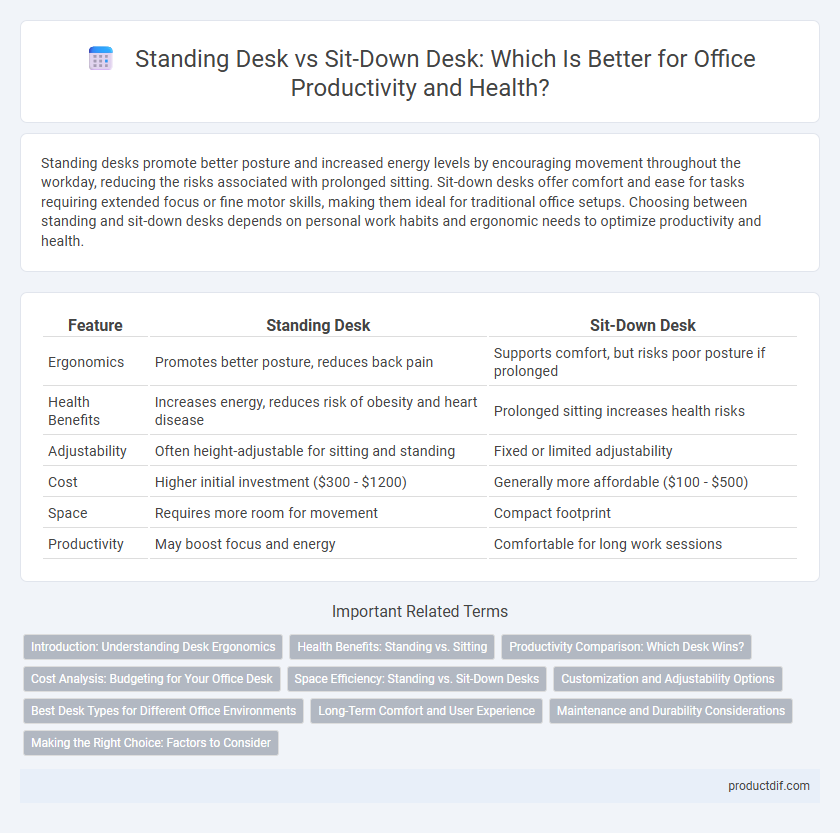Standing desks promote better posture and increased energy levels by encouraging movement throughout the workday, reducing the risks associated with prolonged sitting. Sit-down desks offer comfort and ease for tasks requiring extended focus or fine motor skills, making them ideal for traditional office setups. Choosing between standing and sit-down desks depends on personal work habits and ergonomic needs to optimize productivity and health.
Table of Comparison
| Feature | Standing Desk | Sit-Down Desk |
|---|---|---|
| Ergonomics | Promotes better posture, reduces back pain | Supports comfort, but risks poor posture if prolonged |
| Health Benefits | Increases energy, reduces risk of obesity and heart disease | Prolonged sitting increases health risks |
| Adjustability | Often height-adjustable for sitting and standing | Fixed or limited adjustability |
| Cost | Higher initial investment ($300 - $1200) | Generally more affordable ($100 - $500) |
| Space | Requires more room for movement | Compact footprint |
| Productivity | May boost focus and energy | Comfortable for long work sessions |
Introduction: Understanding Desk Ergonomics
Desk ergonomics play a critical role in promoting comfort and productivity in office environments by reducing strain and improving posture. Standing desks encourage movement and can help alleviate back pain by allowing users to switch between sitting and standing positions throughout the day. Sit-down desks provide traditional support but may contribute to sedentary behavior, emphasizing the need for ergonomic accessories such as adjustable chairs and monitor stands.
Health Benefits: Standing vs. Sitting
Standing desks promote improved posture and reduce the risk of chronic back pain by encouraging an upright position, while sit-down desks can contribute to prolonged sitting-related health issues like obesity and cardiovascular disease. Alternating between standing and sitting throughout the workday helps to increase energy expenditure, reduce muscle stiffness, and improve circulation. Ergonomic adjustments combined with a standing desk setup support musculoskeletal health and enhance overall workplace wellness.
Productivity Comparison: Which Desk Wins?
Standing desks promote increased energy levels and reduce fatigue, often leading to enhanced focus and productivity during work hours. Sit-down desks offer comfort and support for prolonged tasks, but may contribute to decreased movement and potential lethargy. Research indicates that alternating between standing and sitting optimizes productivity by balancing physical engagement and ergonomic comfort.
Cost Analysis: Budgeting for Your Office Desk
Standing desks typically range from $200 to $600, offering ergonomic benefits that may reduce long-term health expenses, while sit-down desks generally cost between $100 and $400, providing a lower upfront investment. When budgeting, consider not only the initial purchase price but also potential costs related to workspace adjustments, maintenance, and health-related productivity impacts. Investing in a standing desk may involve a higher initial cost but can lead to savings through improved employee well-being and reduced absenteeism.
Space Efficiency: Standing vs. Sit-Down Desks
Standing desks optimize space efficiency by allowing users to work in compact areas without the bulk of chair clearance, making them ideal for small offices. Sit-down desks often require additional space for seating and movement, increasing overall footprint. Adjustable standing desks combine the benefits of both, offering flexible workspace adjustments while maintaining moderate space use.
Customization and Adjustability Options
Standing desks offer extensive customization and adjustability options, including height settings that accommodate various user preferences and ergonomic needs. Sit-down desks generally provide fewer adjustable features, often limited to fixed heights or basic tilt adjustments. Advanced standing desks may include programmable height presets and modular components for enhanced ergonomic optimization.
Best Desk Types for Different Office Environments
Standing desks promote better posture and increase energy levels, making them ideal for dynamic office environments that require frequent movement. Sit-down desks provide ergonomic comfort and ample workspace, suitable for tasks requiring prolonged focus and precision. Hybrid desks combine both features, offering flexibility to adapt to varying work styles and improving overall productivity in diverse office settings.
Long-Term Comfort and User Experience
Standing desks promote better posture and reduce the risk of chronic back pain by encouraging movement throughout the day, enhancing long-term comfort. Sit-down desks provide stable support and minimize fatigue for extended periods of focused work, contributing to a consistent user experience. Ergonomic accessories like adjustable monitor arms and anti-fatigue mats complement both desk types, optimizing comfort and productivity over time.
Maintenance and Durability Considerations
Standing desks typically feature durable materials such as steel frames and laminate surfaces designed to withstand frequent height adjustments, requiring minimal maintenance beyond regular cleaning and occasional lubrication of moving parts. Sit-down desks often use solid wood or composite materials that may need refinishing or tightening of hardware over time to maintain stability and appearance. Both desk types benefit from protective coatings and care to extend lifespan and preserve functionality in a high-use office environment.
Making the Right Choice: Factors to Consider
Choosing between a standing desk and a sit-down desk depends on factors like ergonomic benefits, workspace requirements, and health considerations. Standing desks promote better posture and increased energy levels but may cause fatigue without proper adjustment, while sit-down desks offer comfort and reduce strain for prolonged sedentary tasks. Assessing personal work habits, available office space, and the need for adjustable height options are crucial to making the optimal choice.
Standing desk vs Sit-down desk Infographic

 productdif.com
productdif.com